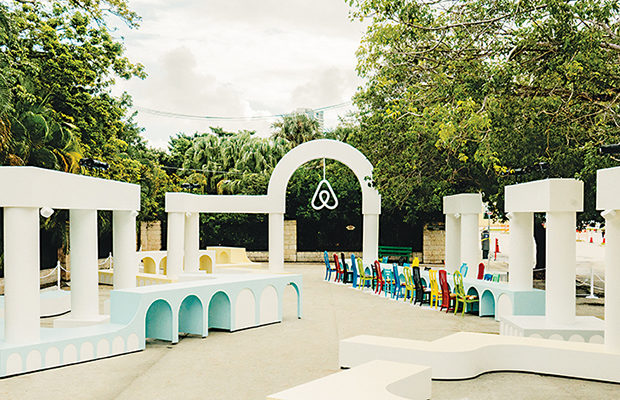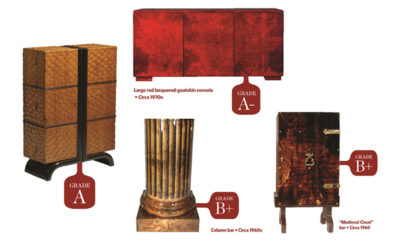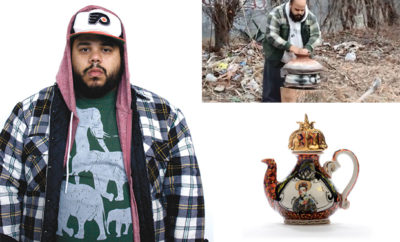 For the 2015 Design Miami, Stewart Hicks and Allison Newmeyer of Design with Company created the Airbnb installation Belong. Here. Now.—a 5,000-square-foot interactive space featuring experiential works and performances hosted by different artists.
For the 2015 Design Miami, Stewart Hicks and Allison Newmeyer of Design with Company created the Airbnb installation Belong. Here. Now.—a 5,000-square-foot interactive space featuring experiential works and performances hosted by different artists.
Architecture
“Style and Substance”: A Look at Architecture Firm Design With Company and the Road to its Recent Star Turn
EVERY YEAR has its breakout performers. In 2015 the spotlight belonged to such young talents as Swedish-born actor Alicia Vikander, Brooklyn author Garth Risk Hallberg—and architects Stewart Hicks and Allison Newmeyer. Like their peers in film and literary fiction, the founders of the Chicago-based studio Design with Company earned broad exposure in the span of just months. In addition to winning the Ragdale Ring pavilion and Robson Redux Design-Build competitions last summer, they presented work at last fall’s first Chicago Architectural Biennial and created the Airbnb installation Belong. Here. Now., mounted across the street from Design Miami in early December.
Architecture with a capital A is rarely mentioned in the same breath as a Hollywood star turn or $2 million debut novel. Yet collapsing the separation of architecture from popular culture is exactly what propels Hicks and Newmeyer forward. Paraphrasing Robert Somol, director of the University of Illinois at Chicago’s school of architecture, Hicks explains, “In the recent past, challenging people as a way of prompting them to think about space has been a bad business model, so getting their attention by more welcoming means seems to have potential.” These partners in work and life approach their practice as a bridge between high discipline and mainstream dialogue.

Design with Company’s Institute for Land Generation earned an honorable mention in the Chicago Architectural Club’s Mine the Gap competition, which called on architects to reimagine new uses for the site of the never-realized Chicago Spire project by Santiago Calatrava. While this mission earned the imprimatur of high-profile clients in 2015, it also spawned a dubious categorization. Design with Company’s desire to engage the public—and, more important, the way it adapts forms from traditional and vernacular architecture to facilitate that mass understanding—just happens to correspond with a reawakened interest in the postmodernist architecture of Charles Moore, Michael Graves, or, notably, 2016 AIA Gold Medal winners Denise Scott Brown and Robert Venturi. Observers wonder whether Hicks and Newmeyer are overtly extending that legacy.
The couple did not set out to make tongues wag, or even to collaborate. They met as juniors at the University of Michigan, after Newmeyer transferred there from Michigan State. Hicks confessses he was immediately attracted to her, even though “we were very different socially.” Newmeyer adds, “I don’t think our design interests were shared at that time; we didn’t click architecturally for a while.”
Personal chemistry prevailed over the distinctions, and after graduation they ventured to Chicago and Princeton, then back to Ann Arbor. They finally landed in Urbana-Champaign in 2008 with teaching gigs at the University of Illinois, studio practices (she at various firms, Hicks as a namesake of Mitnick Roddier Hicks), and marriage on the horizon. But the peripateticism of their early careers was not necessarily leading to a professional happily ever after.

The Van Alen Institute selected Animal Farmatures (below) as one of ten winning entries for its 2011 Life at the Speed of Rail competition. Later that year Design with Company expanded the theme with its Farmland World.
Newmeyer spotted the Chicago Architectural Club’s call for entries for its 2010 Chicago Prize. Called Mine the Gap, the competition requested alternative uses for the site of the unrealized Chicago Spire designed by Santiago Calatrava. “We hadn’t really spoken about it beforehand, but I was in a position at a firm that wasn’t exciting me and I wanted to flex some creative muscles,” she recalls. Mitnick Roddier Hicks was not keen on entering the contest, and Hicks remembers feeling a little lost himself. So, the couple submitted boards for a so-called Institute for Land Generation; ILG reposited the downtown hole as a comic book–like factory of “land patties” that could expand Chicago’s buildable area—a cheeky acknowledgement that the city’s growth was predicated on a long history of earthworks projects.
The architects had treated the concept more as a creatively nourishing lark than a make-or-break decision to start a business. Even so: click. “We knew it was right,” Hicks remembers, “and in some ways we talked about it a lot and we didn’t have to talk about it much at all.” As wedding bells rang in 2010, they formed Design with Company and earned an honorable mention for ILG. The latter prompted Somol to invite Hicks and Newmeyer to teach at the University of Illinois at Chicago shortly thereafter, and since 2012 they have been headquartered in the Windy City, recently moving the studio into the Monadnock Building.
If ILG established a methodology by which historical narrative drives design, Hicks and Newmeyer discovered a signature way of visualizing that approach in the years of their homecoming. Their competition submission to the Van Alen Institute in 2011 and a project associated with the Chicago Prize in 2012 featured, respectively, agricultural equipment disguised as gargantuan farm animals and a monument to Bertrand Goldberg’s Prentice Women’s Hospital whose shape was derived by the trajectory of a wrecking ball nicknamed Bruce. One was inspired by the rural romanticism that accompanied train travel in the 1800s, mashed up with the novelty buildings of mid-twentieth century roadsides. The other riffed off up-to-the-minute headlines, employing the tool of Prentice’s pending demolition as a generator of form. Both grabbed attention, and winked at the stereotype of the too serious architect.

An elevation, section, and reflected ceiling plan for The Monument to Bruce— a proposed monument to Bertrand Goldberg’s Prentice Women’s Hospital.
“Treating a metaphor like it’s real produces a tension and design opportunity,” Hicks says of the perspective underlying both projects. The visual tropes make that slightly esoteric logic instantly relatable: “I think people appreciate it, because they can think through the world the way we do.”
That 2015’s breakout series of realized work relied heavily on widely understood architectural symbols was a natural next step in this progression. In Lake Forest, Illinois, Design with Company’s temporary stage and handmade oversized cushions for the Ragdale Foundation recall the buildings of local architect Howard Van Doren Shaw, owner and designer of the foundation’s namesake house. For Robson Redux, a block of downtown Vancouver was closed to accommodate a terraced stage in a gradation of neon colors; in fact, the partners wrote in a statement, “this project presents an ad hoc arrangement of typical domestic front porches.” And for Airbnb’s Belong. Here. Now. (Hicks and Newmeyer were tapped to subdivide an outdoor plot so that various performances and artistic encounters could take place simultaneously), they put a fantastical twist on ancient urban planning, crisscrossing the space with arcades of various scales.
Before 2015, the neo-postmodernism claim might not have stuck very firmly to Design with Company. Indeed, the high-concept grounding and over-the-top ambition of an Institute for Land Generation could as easily owe a debt to the work of a young Rem Koolhaas or the incisively site-specific projects of Herzog and de Meuron as it could to Scott Brown and Venturi’s charge that Las Vegas “placed symbol in space before form” and that “communication dominates space as an element in the architecture and in the landscape.” Yet the string of projects with which Hicks and Newmeyer secured their presence in 2015 does invite comparison to Scott Brown and Venturi. Their desire to foster intimacy with historic architectural tropes, rendered more like boisterous graphics than rigorous reproductions, invokes themes of “classic” postmodernism—popular appeal, flatness of history, the interchangeability of signifiers.
There is also timing to consider. While the Victoria and Albert Museum staged Postmodernism: Style and Subversion 1970–1990 way back in 2011, interest in the movement kicked into high gear in 2015. Simultaneous with Design with Company’sascent, discussions about postmodernist buildings’ worthiness of landmark protection have regularly dotted the conference schedule, and more than one digital publication has trumpeted a postmodernism revival in which architecture and industrial design parrot the ’80s nostalgia still ricocheting across pop music and fashion.

The City of Vancouver named Design With Company’s entry, Porch Parade—composed of different porch typologies— the winner of its summer design-build competition.
“I feel conflicted about it,” Hicks says of potentially being pegged as a neo-postmodernist. On the one hand, he draws a distinction between Graves’s Portland Building and Design with Company’s Porch Parade in Vancouver. The Oregon icon is “an elevation composition and not a planning project,” Hicks notes, whereas “the flatness of our elevation is countered by the complexity of the plan. The way people weave through it becomes a frame for viewing the city; in all of our projects coordinating people in space is just as important as the elevation.” On the other hand, what’s wrong with commanding attention to the built environment by having fun? And who is to say that the next string of commissions must manifest the researched narrative or resonant metaphor so spiritedly?
“Ultimately it’s a very complicated answer to a question that doesn’t mean that much,” Hicks concludes. That may be so for Design with Company itself, as crediting the neo-postmodernist mantle—by either accepting or rejecting it—could be misinterpreted as trend-mongering rather than as a culmination of sincere, prolonged effort. The labelers, on the other hand, might benefit from not instantly dismissing (or romanticizing) postmodernism and reappraise it with more nuance. “I think our concerns are fundamentally relevant to architecture and not part of a fad,” Hicks says, “in which case we’re all postmodernists.”












